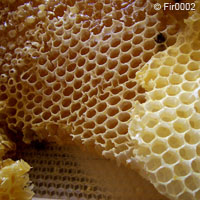Honey more effective than drugs for treating wounds, say scientists
Researchers from the University of Bonn have found that one of the oldest traditional remedies known to man - honey - may offer a better treatment for slow-healing wounds, including MRSA (methicillin resistant Staphylococcus aureus) infection, than established medicines, such as antibiotics. Honey has been used to treat wounds as recently as the Second World War, and is known to have been used in Pharonic Egypt. 'Medihoney' is a special formulation of different honey types, with strong antibacterial properties. 'In hospitals today we are faced with germs which are resistant to almost all the current antibiotics,' said Dr Arne Simon from Bonn University's Children's Clinic. 'As a result, the medical use of honey is becoming attractive again for the treatment of wounds.' The team has been using honey treatments on children with various cancers. The treatments are effective on the malignant cells, but also weaken the immune system 'Normally a skin injury heals in a week, with our children it often takes a month or more,' said Dr Simon. 'Even wounds which consistently refused to heal for years can, in our experience, be brought under control,' said Kai Sofka, wound specialist at the University Children's Clinic, 'and this frequently happens within a few weeks. 'Dead tissue is rejected faster, and the wounds heal more rapidly,' said Dr Sofka. 'What is more, changing dressings is less painful, since the poultices are easier to remove without damaging the newly formed layers of skin.' Despite very positive anecdotal evidence, there have been few clinical studies. Medihoney is now used in some two dozen hospitals around Germany. Researchers led by the University of Bonn, with researchers in Düsseldorf, Homburg and Berlin, will now evaluate the progression of more than 100 diseases and pit the Medihoney treatment against other new types of antibacterial dressing, such as cationic silver. Honey has also been shown to be effective in the treatment of MRSA - the bacteria do not appear to develop resistance to the treatment, as can happen with antibiotic treatments. The Medihoney formulation uses two types of honey - the first contains large quantities of the enzyme glucose-oxidase, which converts the sugar in honey into hydrogen peroxide - a tried and tested antibacterial agent. Because the hydrogen peroxide is released gradually and continuously, the effect is the same as using large quantities of 'raw' hydrogen peroxide. The second honey, leptospermum honey, produced in Australia and New Zealand, has very strong antibacterial properties, even when diluted.
Countries
Germany



